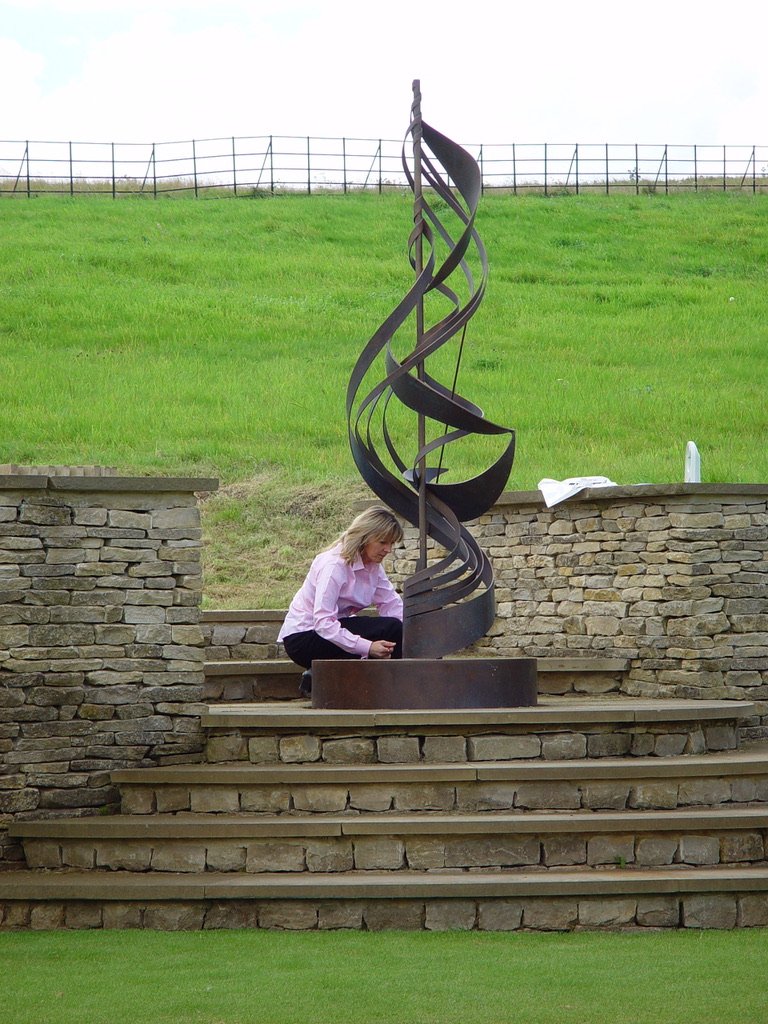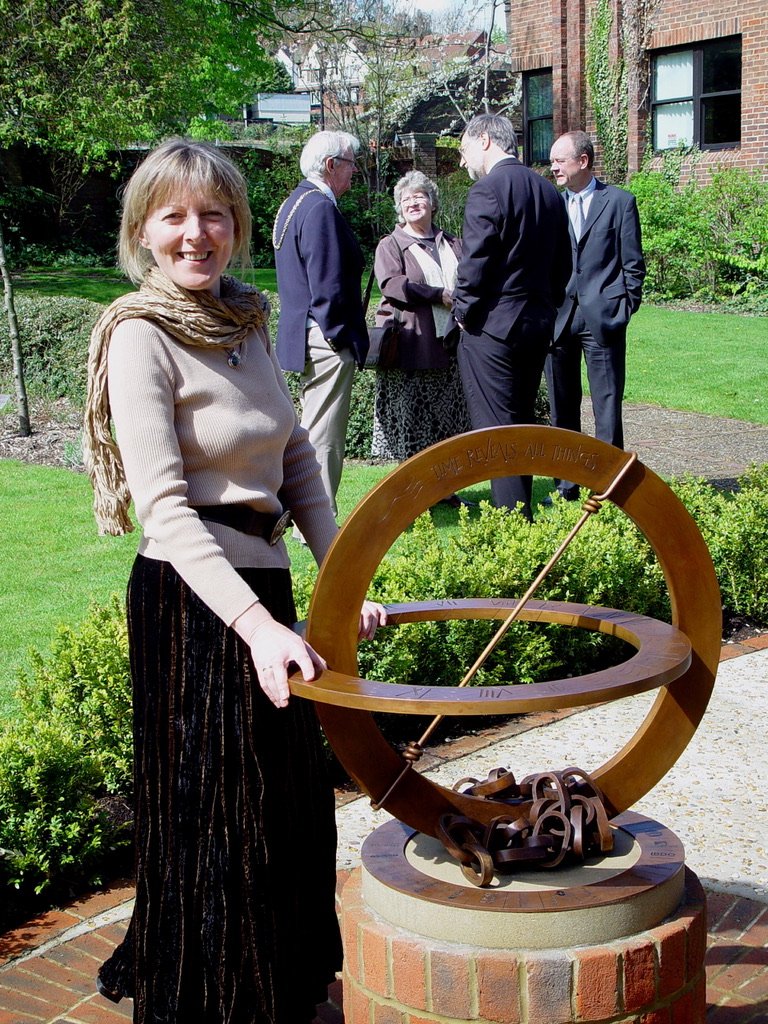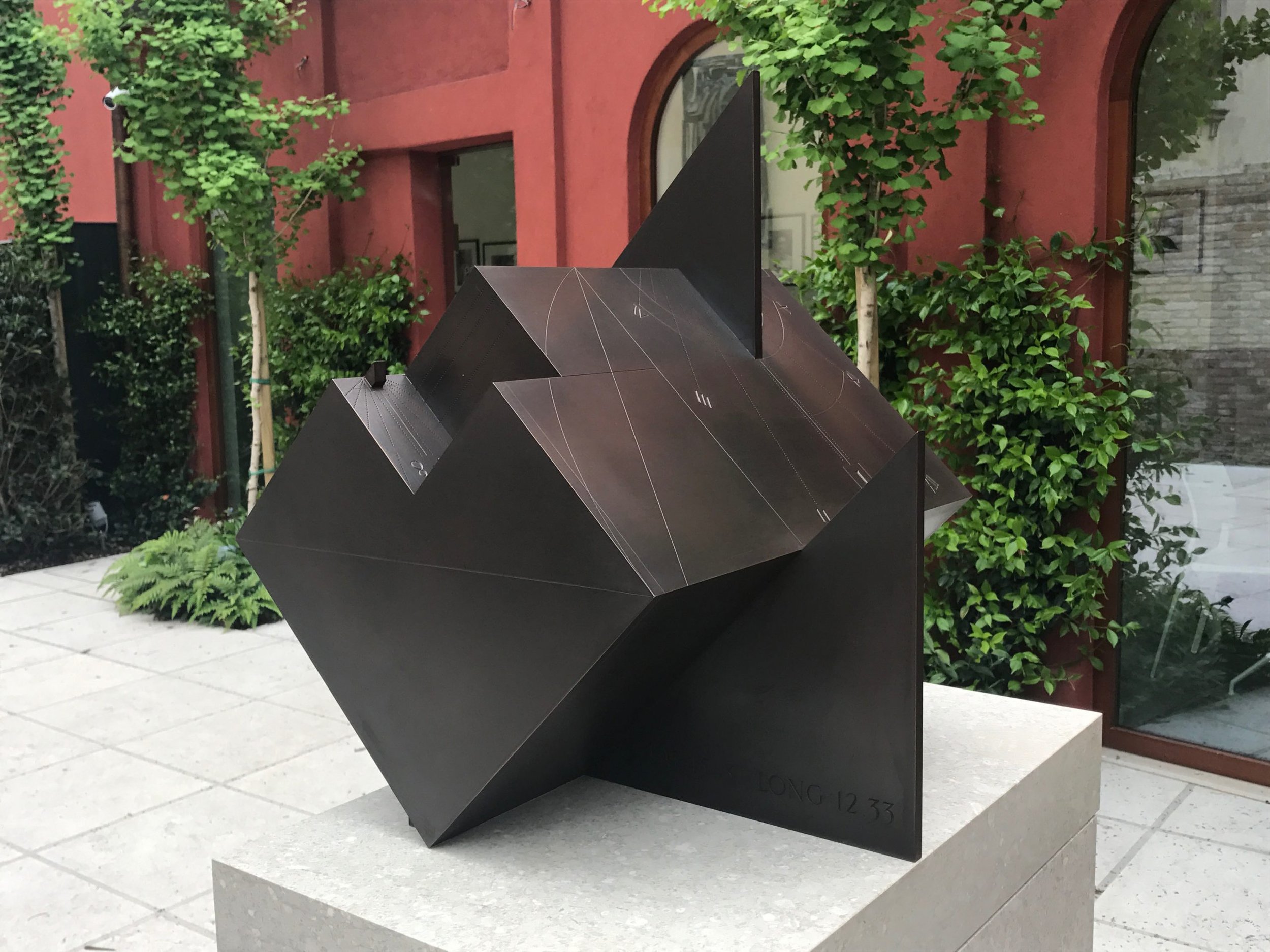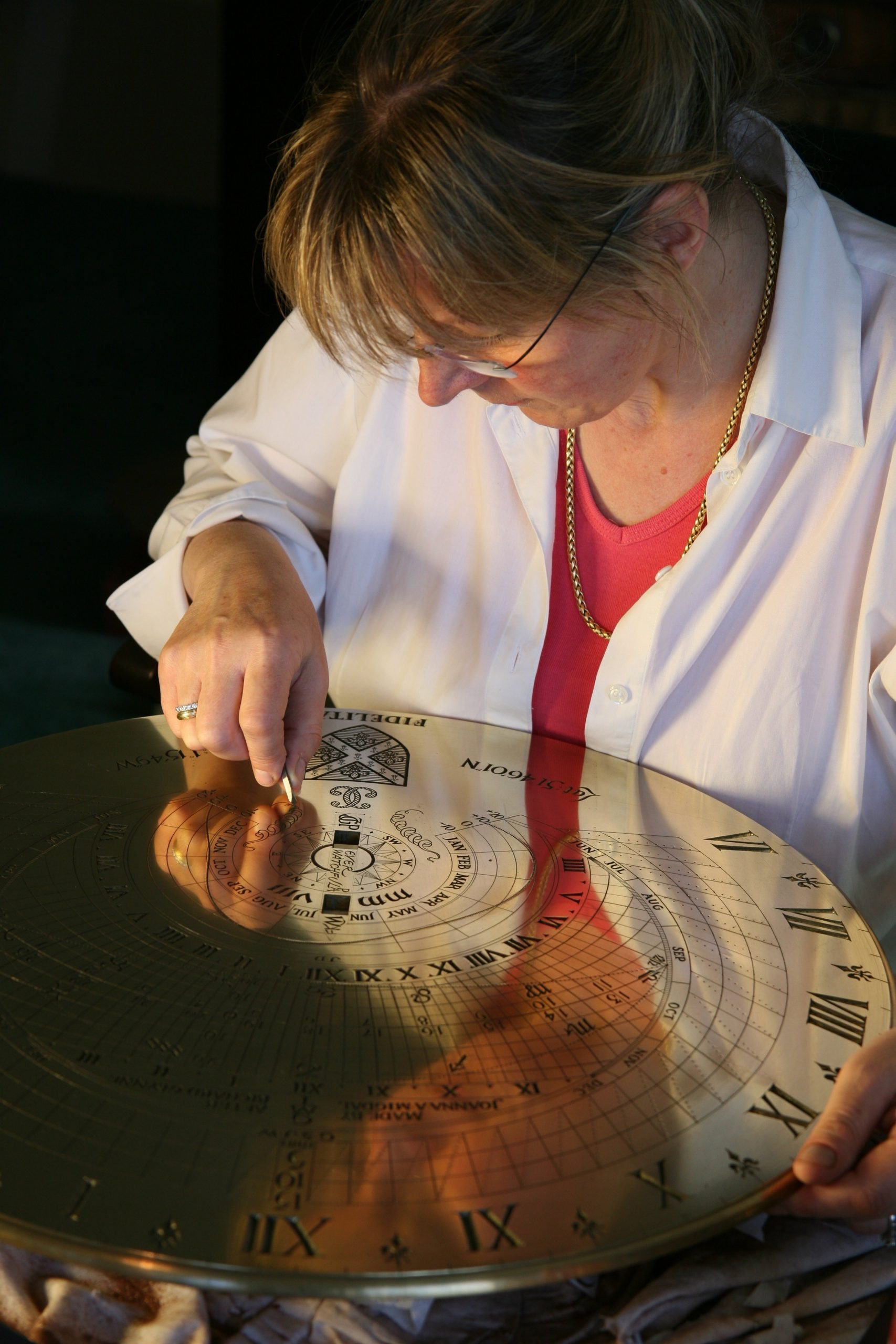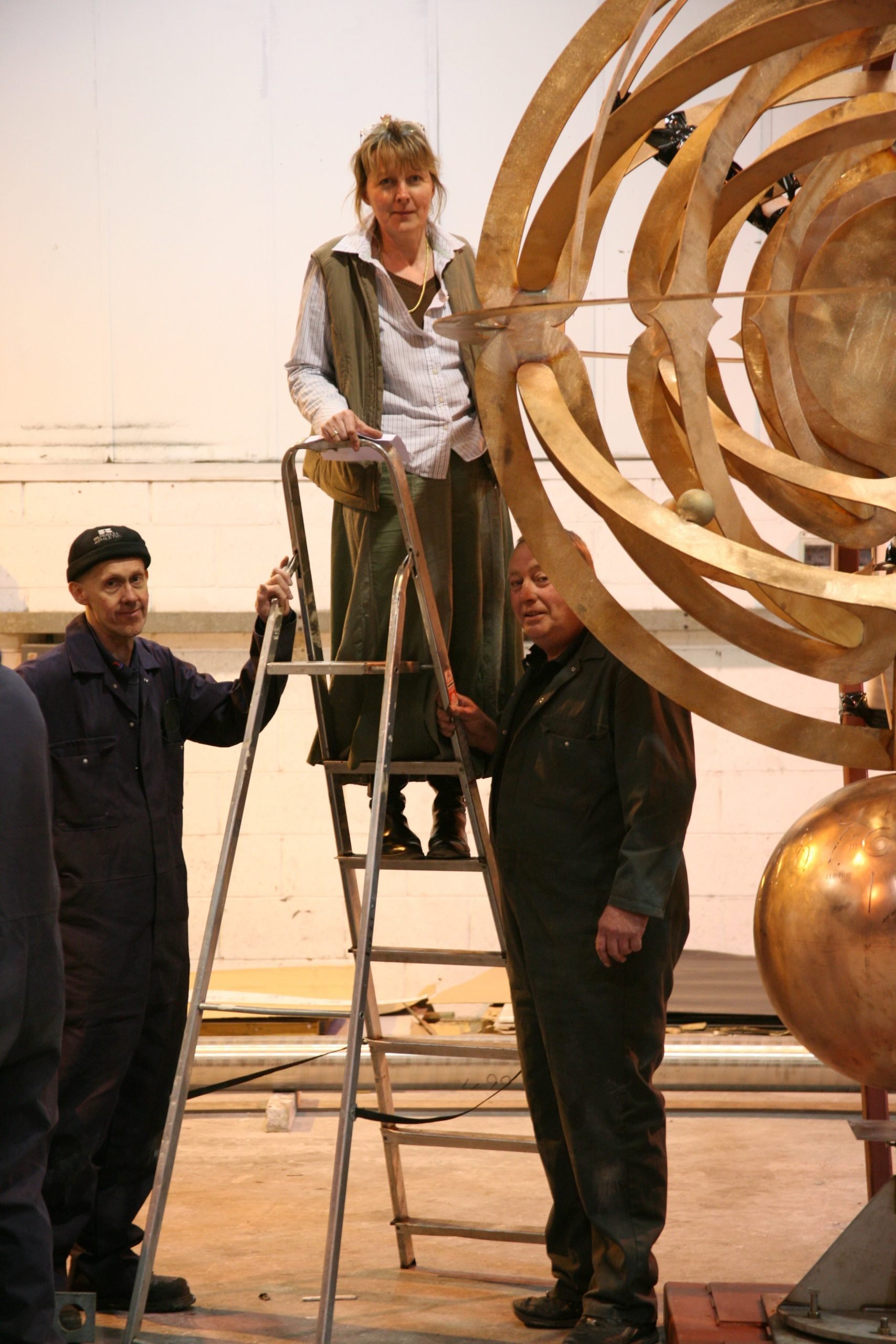Joanna Migdal: Standing the test of time
Metalsmith Joanna Migdal has been creating bespoke sundials for decades. Born from both a creative flair and her use of geometric precision, Joanna’s sundials are one-of-a-kind works of art that respond to her clients’ personalities. For Goldsmiths’ Stories, writer Liza Foreman met Joanna to learn more.
British sundial maker and sculptor Joanna Migdal was the first woman professed horologist to serve as the Master of the world’s oldest horological society, the Worshipful Company of Clockmakers. After studying at the Ealing College of Art, Migdal spent twenty-one-years perfecting the art of crafting sundials by hand at the studio of Edwin Russell with whom she created The Arena sundial in concrete and bronze in 1999. Their Charter of 1631 orders that only “professed horologist” may serve in that role.
In Britain, her work, The Millenium Measure, can be found under the Millenium Bridge in London, and inside Westminster Abbey the piece, Memorial to John Harrison, can also be seen. Other public commissions include the British Medical Association’s bronze memorial for the victims of the Tavistock Square bus bombing on 7 July 2005, a double horizontal dial sundial which currently stands at St Hugh’s College, Oxford University, the Armillary Spheres at Gray’s Inn London as well as sundial at the Globe Theatre.
Alongside this, she has spent forty years creating public and private pieces for collectors and public institutions, not only in Britain but around the world. For the Guggenheim Collection in Venice, she made a Cubist sundial sculpture in bronze and marble, as a memorial to Peggy Guggenhein. The 4orty 5ive sundial was unveiled in 2017.
How did you begin sun-dial making?
After a childhood of loving both drawing and maths, I was asked by my school to choose between them. I chose art. In those days you could not do both. After a year at art school trying everything, a week on this, and a week on that, I was not at all clear in which direction I was set for. In the end I chose to do metalwork and jewellery at St Martins. However, during the summer before starting the course, I visited the very first “Art in Action” display in 1977. There I saw an amazing silversmith called Peter Howell. He was making a small silver box. I asked him how long it would take to finish. “Oh, about a month,” he said. My heart absolutely leapt. I realised in that moment that is what I wanted to do – to find something that I could devote myself to in the same way that he was devoted to that little silver box.
I went to the organiser of the show, Bernard Saunders, and asked if there was anyone he knew who would take an apprentice. I wanted someone who had that complete dedication – which I had not seen at art school. He did, and that is how I turned up at the studio of Edwin Russell. He was working at the time on that most sublime of sundials, the two dolphins at Greenwich, to celebrate the Queen’s Silver Jubilee. Again, my heart leapt. No one had told me you could make sundials like that. It was eye opening. How utterly perfect, maths and art reunited.
How does the story continue?
I stayed at the studio for 21 years. After a seven-year apprenticeship, I became a journeyman to learn engraving, welding, engineering and more, later returning to that studio to set up my own business. We worked together on many projects, though no one has ever bettered the Silver Jubilee Dolphin dial that Edwin set out and sculpted. It remains my all-time favourite.
What’s your working process?
I suppose my true working process is to try my hardest to make everything more and more perfect. As an apprentice, the one sentence my master teacher repeated to me, over and over again, was that the expression, “that will do” is completely unacceptable. The work must come first, regardless of everything else.
At every level there is a need to be “rigid and flexible,” and that is why I love making sundials. Each design has two features. One part is utterly fixed by the rules of astronomical principle, and the other, the artistic side, gives total freedom to design what you want in an unlimited way.
How do you collaborate with clients?
My working process on a new commission is the same each time and it seems to work. I invite the client to the studio to look at models of past work, and to look through a large portfolio of photographs. In this informal relaxed setting it becomes clear what sort of design the client likes and what they find appealing. I ask them to think in an unlimited way. It is my problem to convert their thoughts into a sundial, so they can think without any worry. I then ask them for special quotes and what is important to them. Any other thoughts they have may really help. I then go to visit their garden or house and see where the sundial sculpture would work best. Nothing is fixed yet. Seeing the garden and house often gives more of a sense of what the client may like and what may work in that location. Sometimes ideas and designs arrive immediately, and they are drawn up. Sometimes the design literally creates itself with the client so neither of us could have done it without the other. Sometimes though, it takes days and days of sitting in front of a white sheet of paper reflecting on the commission.
Can you talk about jewellery and sundials?
I originally set out to do metalwork and jewellery, and this desire has never left me. When I was commissioned to make a sundial for the Peggy Guggenheim Collection in Venice, I made a pair of sundial earrings to wear to the unveiling. They were designed and calculated to tell the time at that spot. If either earring is placed on the perfectly positioned plinth of the large commissioned sundial, it will tell the time in summer on its upper face and winter on its lower face. Despite their small size, the earrings are surprisingly accurate. Making them reminded me how much more difficult it is to make very small precise pieces than very large pieces. The skill is incredible. Working in such thin metal again meant I met a wonderful group of silversmiths and goldsmiths in the Goldsmiths Company and the Goldsmiths Centre. I had to learn a whole new set of skills, though working under such magnification reminded me again of Peter Howell and his perfect silver box.
Can you talk about working in metals?
The best part of serving an apprenticeship in a working studio is the opportunity to try so many different skills and to work with so many different materials. Somehow, certain materials appeal. I was drawn first to phosphor bronze, brass coming second. Aluminium is not for me, even though I trained as a welder with aluminium, I could not dedicate my work using it. I found that of all the metals I was drawn to bronze. I loved it and it suited me. It was powerful, it was flexible, and it could be welded. It took colouration well. It could be bent, softened and cast. It could be engraved precisely and sharply. It was great in the lathe. It is lovely to grind. It is just the best for me.
How do you come up with your ideas?
Usually, I like to have several ideas to offer. I make up small maquettes for the client to see. Often clients find this a useful way of visualising the sculpture. Once agreed, I make a full-scale wooden mock-up and we try this on site. When working abroad, I take a kit of cardboard and glues etc. and have been known to have my hotel room completely covered in half assembled pieces. Then the next stage is to draw up accurate engineering style drawing and start cutting metal.
Multi-Tasking
Having a variety of commissions at different stages of completeness is wonderful. When creating a design gets too intense, total attention to some hand engraving for instance, where one slip can ruin an entire job often seems to free the creativity deep inside. Suddenly in the midst of that kind of concentration, a design will arrive. This process is magical, scary and totally unpredictable. Time does not operate.
Which tools do you use?
I have a lathe and welding equipment so everything can be made in my studio. All the lettering fonts are designed by me and hand engraved. On the larger pieces, I work with a skilled set of engineers and sheet metal workers, or at the bronze foundries and we do a lot of the initial work to form my full-scale models into CAD. The mix of using modern high-tech equipment and hand work is fabulous and offers a whole world of new possibilities. I really enjoy this one-off process, though occasionally I will do a limited edition of pieces, but of course each piece must be calculated and made for [each] particular location.
Describe your typical working day?
This is the ideal, but as ever it varies. My studio is designed very much with the apparent movement of the sun at heart, so each area receives the light for a particular type of work during the day. The mornings tend to be when I engrave and do the fine work filing and cutting, the longer shadows give a clearer visibility. The early afternoon light falls on the part of the studio where I design and make models in card and wood and play with creative ideas. The late afternoon light falls into the office, where I can draw up lettering and do admin-type work.
What does a studio mean to an artist?
Absolutely everything. I, like many other artist friends, love their studios as it is where they are themselves. The studio is one’s creative home. Usually, artists work alone and enjoy that. The studio surrounds one with lots of tools and drawings and models and one is totally immersed in what one loves most. I cannot imagine anyone would be an artist unless they really wanted to and could not help themselves. It is not an easy life, but it is so satisfying. Elizabeth Gilbert gives a fantastic Ted Talk about “genius”, and the need not to take all of the credit for one’s ideas, if one does, the creative spirit tends to dry up, and either one just repeats what [they have] done before or takes to the bottle. The studio is a place where one can just wait, where one plays, where one can allow the magic to happen or not. Where one can be quiet away from the hubbub of usual demands. It is incredibly lucky to have a place that is just for art. Everything in one’s studio, from an interesting stone or a leaf to a mass of tiny model ideas and drawings, allows one to become fully immersed and happy at play.
What do you like most about your process?
Recognising that something really works as a design, and wondering how on earth that happened, is the most satisfying aspect. You cannot make a design happen, but you must be ready to grab it when it shows up. As a student I thought if only I kept working and working and taking it all very seriously and getting better and better, I would “get there”. My master teacher was brilliant and would make me cry seeing some of the beauty of his drawing and ideas. I was lucky, as part of my seven years apprenticeship included enlarging some of his drawings and models. That gave me a sense of proportion. You get a “feeling” for what works.
When commissions came into the studio, we were all given the brief he had, and asked to have a go at a design. The designs I came up with, despite my intense ambition, were never as good as his and I kept asking “why why why?” I remember clearly one day getting a glimpse of him at work, drawing a design. Suddenly I saw that he was like a child playing with a pencil and paper and it was this utter ease of skill and observation that allowed designs to flow through him.
Like a gymnast, the need is to teach your entire body the skills and allow the creativity to flow through. You cannot play a violin unless you have practised and practised and practised boring scales over and over again. So it is with art. You need a background of observation, drawing, practising engraving, over and over and over again. You must come to understand your metals, what you can do with them, how far each material will let you push it, how sharp your graver needs to be or what the angle for the face of the graver needs to be to let you cut the metal with the most ease and crispness. In time it begins to feel easier and natural but there is always further to go. Always.
Has sundial making changed over the centuries or have you changed it somehow?
The principles have not changed. The main change is that they are no longer used as the main way of telling the time or to regulate clocks. Some may think that they are now redundant, but accurate time when shown on a sundial, is magical. It is no wonder that they so often traditionally have deeply philosophical and religious quotations engraved on them. Properly calculated dials remind us of our place in the universe and of the incredible mathematical complexity of the solar system. They can teach artistry, maths, and geography. They can teach meditation by demonstrating the natural rhythms of the day. They can tell the time by the moon – and they can be beautiful.
Sundials on the go
It is a fact that any spot on which a sundial stands is unique. A sundial made to work there cannot be moved. Even a football pitch facing East-West has a 1/4 second difference of time from one end to another. Sundials can only be guaranteed accuracy all year within 1.5 minutes, as the refraction of light in the air can vary depending on weather conditions, and this is unavoidable. The most noticeable change in the last twenty years has been that, in the past people and families did not move very much and the fact that the sundial was made for the exact location was special. However, as people move, the fact that the sundial only works in one place, (though I can change angles of plinths etc. so they can be moved) has recently become a reason for not commissioning a sundial.
Innovation for nomads
I made a real turn around and looked to how to make a more universal design that could be adjusted if the client moves. This has been the greatest change I have noticed. In places like Ireland, there is much more of a sense of staying in one location and so far this has meant that a sundial is for life in that one location. I have had to turn around my whole way of thinking and it kept me on my toes.
What skills are needed?
Skills needed are love of maths and astronomy, an obsession with precision and a joy in both these things. When a sundial is finished and correctly set up, watching the shadow move precisely to the hour lines “on time” is truly the most extraordinary feeling. The maths are totally unforgiving. The dial is either right or it is not. That is that, and that is what I love. There is no “grey area” as there is in some professions like the law, where one can explain away anything by a succession of clever words. The apparent movement of the sun is remarkably consistent, so the sundial needs to be made as a complete reflection of it as is possible.
How long do pieces take?
Too short a time for me and too long a time for the client waiting for the sundial. I am delighted to say that no one has ever cancelled or said they are not happy. So very many clients have become great friends. The great client creates the atmosphere for great work.
What are the designs that you are most proud of?
The proudest and the saddest sundial is probably the one I was asked to make for the garden of the British Medical Association to commemorate and celebrate the work of the doctors there, immediately following the 7th July bus bombing in Tavistock Square. I was told that the effects on all present had been so traumatic, that those working in the building at the time, did not want to be reminded of it on a daily basis. They simply wanted a place to reflect, once a year. There were not huge funds available, so I designed a simple horizontal garden dial on a simple stone plinth, which to all intents and purposes appears to be a modest piece of traditional garden sculpture.
The design of the circular dial however, is packed with symbolism. It is made to demonstrate that whatever the bomber thought he might have achieved, life, and time, still continue, and light shines where there is darkness. Furthermore, the plinth is designed in such a way that on 7th July each year, and only on that day, its own shadow falls on an incised gilded line on the step below, at precisely the moment that the bomb exploded. At that moment light is divided from darkness and symbolically, good from evil. It has proved a very powerful and emotional sculpture, which has been known to reduce those around it to tears.
Is confidence important?
From experience, I would say that most good artists have very little, if any, but you do the job anyway. Often, I hear people saying “I will be an artist when I get sufficient confidence”, but the true artist cannot help themselves and just goes for it. Waiting for confidence is a lifetime’s work with no guarantee. For me, art is the one area that you cannot help yourself pursue. Being very quiet and diving deep into one’s strange unknown creative side, needs courage, playfulness and huge respect. You cannot fix it. You need to be ready to follow when you are moved with an idea. Sometimes you are prepared to be desperate – but you never ever ever give up.
What’s the future of sundial making?
It is sad that the majority of present-day makers seem to fall into one of two groups. The first turn out supposedly decorative dials in large numbers. These I call “shadow show-ers” because they are not properly calculated. While they cast moving shadows, they will never tell the time. The second group produces expertly calculated dials with machine-made accuracy, but lacking any sort of artistry, light-heartedness or fun. My ambition in contrast is always to create sundials that are not only beautiful and personal but keep accurate time for the place for which they are made.
Are there many people still making sundials today?
Of professional sundial makers, there are some, but not many. There are still some in America, Israel and Australia as well as a number in Europe and in this country. Mainly they work in stone, or machine engraved, acid-etched or spark eroded metal. The rarest of all are probably those who hand-engrave metal as I do and always will. Machine and computer controlled engraving methods produce wholly lifeless results. Hand engraving, now being enthusiastically revived by The Hand Engravers Association of which I am a Patron, remains in my view, in a league of its own. Hand engraving reflects light and shade in such a lively fine way.
Written by Liza Foreman | Photography by George White


